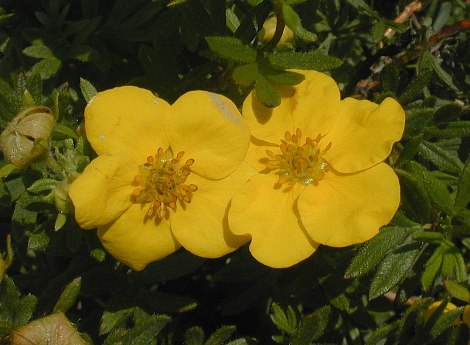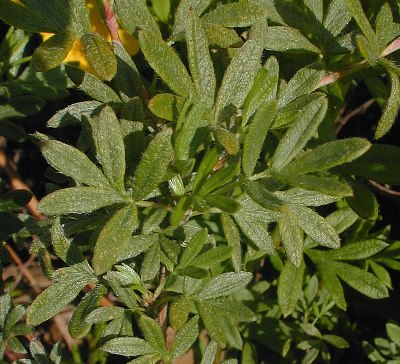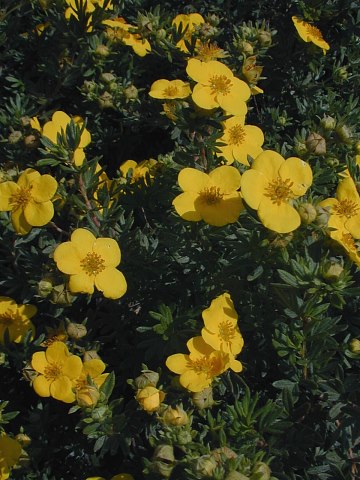Description: This plant is a small much-branched shrub about 1½–3' tall. The bark of the woody branches is reddish brown to grayish brown, becoming shredded and ragged-looking with age. The alternate leaves are about ½–1" long and across; they are divided into 3-7 narrow pinnate lobes and their margins are smooth and revolute (folded downward). The lobes often appear to be palmate because they are crowded together; they are linear-oblong in shape. The upper surface of each leaf is medium to dark green and sparsely covered with fine silky hairs; the lower surface is pale green and more densely covered with fine hairs. The leaves have short petioles.

The upper branches produce either individual or small clusters of yellow flowers. Each flower spans about ¾–1½" across; it has 5 yellow petals that are well-rounded, 5 yellowish green sepals, 15-20 stamens with flat golden anthers, and multiple carpels (female reproductive organs) that are crowded together in the center. The sepals are ovate in shape and sparsely covered with fine silky hairs. On a particular shrub, many flowers may bloom at once, or only a few flowers at a time. The blooming period occurs during the summer and early fall; a small colony of shrubs may remain in bloom for 2-3 months. Each flower is replaced by a capsule that contains several hairy seeds. Mature capsules become dark brown and persist into the winter. The root system consists of a woody taproot.
Cultivation: Shrubby Cinquefoil prefers full sun, moist conditions, and a sandy or rocky soil containing calcium. The pH of the soil should be slightly acid to alkaline. Shrubby Cinquefoil can be cultivated in a garden soil containing loam or clay-loam, and it will adapt to drier situations.

Range & Habitat: Shrubby Cinquefoil is a rare plant in Illinois; it is found primarily in a few counties in the NE section of the state (see Distribution Map), where it is native. Habitats include fens, calcareous seeps, the upper portion of beaches and low sandy areas along Lake Michigan, sandy banks of interdunal ponds, moist dolomite prairies, and hill prairies. The last habitat is highly atypical. Shrubby Cinquefoil is typically found in calcareous wetlands near Lake Michigan and other Great Lakes; it rarely naturalizes in disturbed areas. Because of its attractive flowers and easy culture, Shrubby Cinquefoil is often cultivated as an ornamental plant in gardens and lawns. This circumboreal shrub is also native to Eurasia.
Faunal Associations: According to observations of Müller (1873/1883) in Germany, the nectar and pollen of the flowers attract honeybees, Halictid bees, Sphecid wasps, and various flies. Observed fly visitors include: Soldier flies, Syrphid flies, Thick-headed flies, Flesh flies (Sarcophaga spp.), Blow flies (Lucilia spp.), Dung flies (Scatophaga spp., Sepsis spp.), and Anthomyiid flies. The caterpillars of the butterfly Lycaena dorcas (Dorcas Copper) feed on the foliage of Shrubby Cinquefoil, while the caterpillars of the moth Scopula limboundata (Large Lace Border) eat the flowers. Another insect that feeds on Shrubby Cinquefoil is the flea beetle Macrohaltica caurina. With the exception of goats, hoofed mammalian herbivores don't browse on this shrub to any significant extent.

Photographic
Location:
A roadside garden in Champaign, Illinois.
Comments:
Other scientific names for this species includes Potentilla
fruticosa and Pentaphylloides
floribunda. While the floral structure of Shrubby
Cinquefoil (Dasiphora
fruticosa)
resembles that of the various cinquefoil species (Potentilla
spp.), the latter are non-woody plants with smaller flowers
(¼–¾" across). Another species, Three-toothed Cinquefoil (Sibbaldiopsis
tridentata), is a low woody plant with small white
flowers; it more closely resembles a wild strawberry (Fragaria
sp.) than Shrubby Cinquefoil.